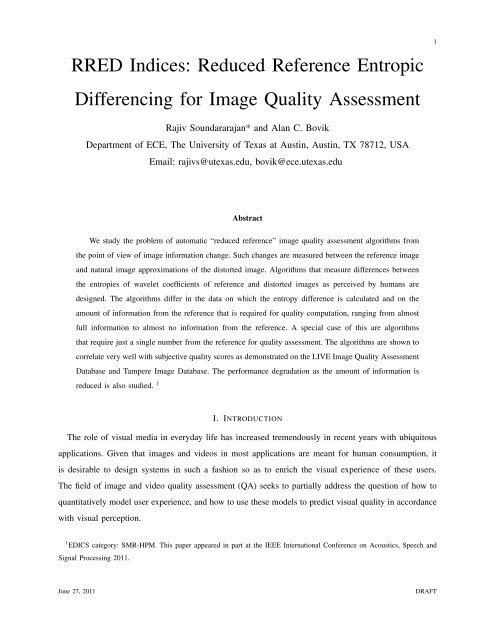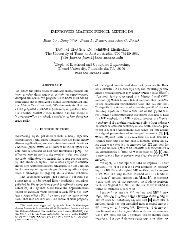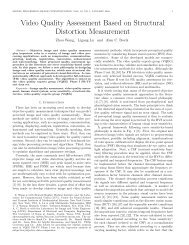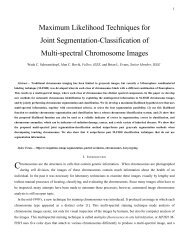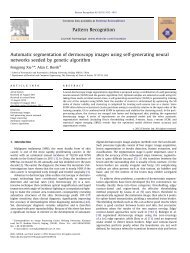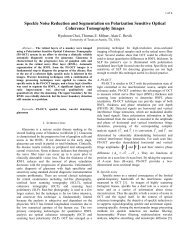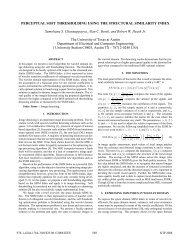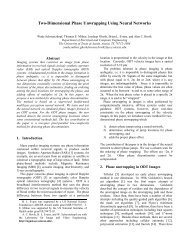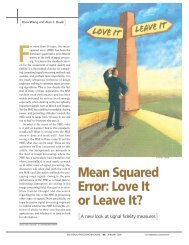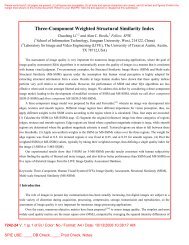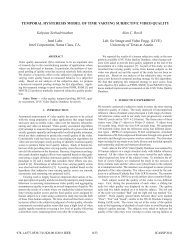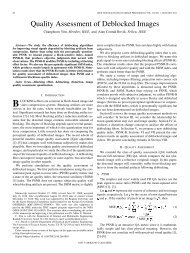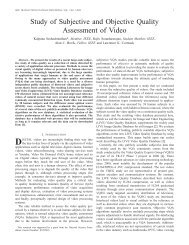Reduced Reference Entropic Differencing - The University of Texas ...
Reduced Reference Entropic Differencing - The University of Texas ...
Reduced Reference Entropic Differencing - The University of Texas ...
You also want an ePaper? Increase the reach of your titles
YUMPU automatically turns print PDFs into web optimized ePapers that Google loves.
RRED Indices: <strong>Reduced</strong> <strong>Reference</strong> <strong>Entropic</strong><br />
<strong>Differencing</strong> for Image Quality Assessment<br />
Rajiv Soundararajan* and Alan C. Bovik<br />
Department <strong>of</strong> ECE, <strong>The</strong> <strong>University</strong> <strong>of</strong> <strong>Texas</strong> at Austin, Austin, TX 78712, USA<br />
Email: rajivs@utexas.edu, bovik@ece.utexas.edu<br />
Abstract<br />
We study the problem <strong>of</strong> automatic “reduced reference” image quality assessment algorithms from<br />
the point <strong>of</strong> view <strong>of</strong> image information change. Such changes are measured between the reference image<br />
and natural image approximations <strong>of</strong> the distorted image. Algorithms that measure differences between<br />
the entropies <strong>of</strong> wavelet coefficients <strong>of</strong> reference and distorted images as perceived by humans are<br />
designed. <strong>The</strong> algorithms differ in the data on which the entropy difference is calculated and on the<br />
amount <strong>of</strong> information from the reference that is required for quality computation, ranging from almost<br />
full information to almost no information from the reference. A special case <strong>of</strong> this are algorithms<br />
that require just a single number from the reference for quality assessment. <strong>The</strong> algorithms are shown to<br />
correlate very well with subjective quality scores as demonstrated on the LIVE Image Quality Assessment<br />
Database and Tampere Image Database. <strong>The</strong> performance degradation as the amount <strong>of</strong> information is<br />
reduced is also studied. 1<br />
I. INTRODUCTION<br />
<strong>The</strong> role <strong>of</strong> visual media in everyday life has increased tremendously in recent years with ubiquitous<br />
applications. Given that images and videos in most applications are meant for human consumption, it<br />
is desirable to design systems in such a fashion so as to enrich the visual experience <strong>of</strong> these users.<br />
<strong>The</strong> field <strong>of</strong> image and video quality assessment (QA) seeks to partially address the question <strong>of</strong> how to<br />
quantitatively model user experience, and how to use these models to predict visual quality in accordance<br />
with visual perception.<br />
1 EDICS category: SMR-HPM. This paper appeared in part at the IEEE International Conference on Acoustics, Speech and<br />
Signal Processing 2011.<br />
June 27, 2011 DRAFT<br />
1
Image and video QA algorithms can be broadly classified into full reference (reference available or<br />
FR) and no reference (reference not available or NR) algorithms. <strong>The</strong> mean squared error (MSE) has<br />
been used as a quality metric for a very long time, owing to its simplicity, despite having a very poor<br />
correlation with human perception [1]. <strong>The</strong> last decade has seen significant progress in the field <strong>of</strong><br />
objective full reference image/video QA algorithms. <strong>The</strong> structural similarity index (SSIM) [2], visual<br />
information fidelity (VIF) [3], visual signal to noise ratio (VSNR) [4] and just noticeable difference (JND)<br />
metrix [5], are examples <strong>of</strong> successful full reference algorithms which have been shown to perform well<br />
in predicting the quality scores <strong>of</strong> human subjects.<br />
Progress on no reference QA, however, has been very slow. Indeed, the progress that has been possible,<br />
has been on account <strong>of</strong> relaxing the no reference assumption in various ways. One approach is to devise<br />
NR algorithms for a specific type <strong>of</strong> distortion only [6], [7], [8]. This approach can be refined by assuming<br />
that the distorted image is subjected to a set <strong>of</strong> possible distortions known a priori. Training based NR<br />
QA techniques have resulted in algorithms that perform at least as well as mean squared error, which has<br />
the benefit <strong>of</strong> a reference image [9], [10]. In [11], blind image quality assessment indices that measure<br />
the anisotropy in the distorted image through the Renyi entropy are introduced. However, performance <strong>of</strong><br />
this index has not been thoroughly evaluated on a large and comprehensive dataset. Alternatively, partial<br />
information about the reference can be made available, which can be used along with the distorted image<br />
to predict quality. This paradigm is known as reduced reference (RR) QA, which may or may not require<br />
knowledge <strong>of</strong> the distortion type.<br />
RR QA algorithms involve sending or supplying some amount <strong>of</strong> information about the reference along<br />
with the distorted image that is useful in quality computation. For example, the concept <strong>of</strong> quality aware<br />
images was proposed in [12], where partial reference image information is embedded within the image<br />
and can be extracted reliably despite distortions. <strong>The</strong> information embedded could for example, be the<br />
statistical parameters <strong>of</strong> the distribution <strong>of</strong> wavelet coefficients obtained by a multi scale-space-orientation<br />
decomposition <strong>of</strong> the reference image. <strong>The</strong>n, two parameters <strong>of</strong> a generalized Gaussian distribution and the<br />
error in approximating the empirical coefficients by this distribution are transmitted for every subband.<br />
<strong>The</strong> quality is based on computing the Kullback-Leibler (KL) divergence between the parametrized<br />
distribution <strong>of</strong> the reference and the empirical distribution <strong>of</strong> the distorted image. <strong>The</strong> performance <strong>of</strong><br />
this algorithm is good only for certain individual distortion categories. This idea is further extended in<br />
[13], where an additional divisive normalization transform step is introduced before computing the KL<br />
divergence to improve performance. However, this algorithm depends on a number <strong>of</strong> parameters that<br />
need to be trained on databases. <strong>The</strong>re has also been prior work on non-statistical reduced reference<br />
June 27, 2011 DRAFT<br />
2
methods that compute a generalized norm between selected wavelet coefficients <strong>of</strong> the reference and<br />
distorted images [14]. <strong>The</strong> coefficients are selected in a way that reduces the information required while<br />
still maintaining good performance.<br />
Algorithms based on multiscale geometric analysis including curvelets, bandlets, wavelets and con-<br />
tourlets are developed in [15]. <strong>The</strong>se algorithms depend on parameters that need to be tuned delicately<br />
on different databases. Moreover, their performances degrade severely with the reduction in the data rate<br />
required from the reference. Algorithms designed in [16] for color images, perform well when tested<br />
on images belonging to certain distortion classes such as JPEG or JPEG2000. While distributed source<br />
coding ideas are applied to approximate mean squared error in [17], RR QA algorithms based on color<br />
distribution <strong>of</strong> images are developed in [18], and training based approaches are used in [19]. <strong>The</strong>se<br />
algorithms are either limited in their ability to achieve good performance across different distortion types<br />
or involve training on databases. <strong>The</strong> algorithm by [20] based on Weibull statistics <strong>of</strong> wavelet coefficients<br />
achieves good performance at a given data rate. However, what we desire in this work, is a family <strong>of</strong><br />
algorithms that achieve graceful degradation in performance with the reduction in data rate and the ability<br />
to achieve better performance with increase in data rate.<br />
In this paper, we develop a new framework <strong>of</strong> reduced reference QA algorithms that are information<br />
theoretic. We consider natural image approximations <strong>of</strong> the distorted image in the sense that wavelet<br />
coefficients <strong>of</strong> distorted images will be fitted with Gaussian scale mixture distributions. In effect, this<br />
paper approaches the problem <strong>of</strong> quality assessment from the perspective <strong>of</strong> measuring distances between<br />
the reference image and the projection <strong>of</strong> the distorted image on to the space <strong>of</strong> natural images. <strong>The</strong><br />
algorithms compute the average difference between scaled entropies <strong>of</strong> wavelet coefficients <strong>of</strong> reference<br />
and projected distorted images that are obtained at the output <strong>of</strong> a neural noise channel. A family <strong>of</strong><br />
algorithms are proposed depending on the subband in which the quality computation is carried out and<br />
the amount <strong>of</strong> information required from the reference image. This framework allows us to study how the<br />
performance <strong>of</strong> these information theoretic RR QA algorithms decays with reduction in the amount <strong>of</strong><br />
information used from the reference. Since, the reference information scales with the size <strong>of</strong> the images,<br />
the algorithms are also applicable in scalable image and video QA [21]. Further, the algorithms allow<br />
for bidirectional computation <strong>of</strong> quality, by which we mean that the quality <strong>of</strong> the distorted image can<br />
also be computed at the reference if relevant information from the distorted image is made available. In<br />
other words, by supplying reduced information from the distorted image through a feedback channel, its<br />
quality can be computed at the reference without sending any information in the forward channel. This<br />
feature has potential applications in image/video quality monitoring in networks, which requires feeding<br />
June 27, 2011 DRAFT<br />
3
ack the quality at different nodes in the network to the sender. Of course, since the quality index is<br />
based on the absolute difference, it does not indicate which <strong>of</strong> the two images is the reference image. In<br />
nearly any imaginable scenario, we know which <strong>of</strong> the two images is the reference. Another interesting<br />
feature <strong>of</strong> these algorithms is that they are not dependent on any parameters that need to be trained on<br />
databases. Depending on the bandwidth available for information supplied either from the reference or<br />
distorted image, one algorithm from this class may be picked for desired applications. <strong>The</strong> framework<br />
also allows users to choose an algorithm from this class for general purpose or distortion specific quality<br />
assessment.<br />
<strong>The</strong> rest <strong>of</strong> the paper is structured as follows. In the following section, we describe prior information<br />
theoretic approaches that motivate the algorithms developed in this paper. In Section III, we present the<br />
main theory and resulting algorithms <strong>of</strong> the paper. We discuss perceptual interpretations <strong>of</strong> the algorithms<br />
in Section IV, and present numerical results in Section V. It is found that the performance attained is<br />
highly competitive on a large and comprehensive database <strong>of</strong> distorted images and subjective scores.<br />
Finally, we conclude the paper in Section VI.<br />
II. INFORMATION THEORETIC APPROACHES TO QA<br />
Information theoretic methods for quality assessment have produced some <strong>of</strong> the best performing full<br />
reference (FR) QA algorithms, including the information fidelity criterion (IFC) [22] and the visual<br />
information fidelity (VIF) index [3]. <strong>The</strong> motivation for such an approach is that image distortions tend<br />
to disturb the natural statistics <strong>of</strong> images and quantifying this disturbance can determine quality. It is also<br />
based on the assumption that such modifications <strong>of</strong> natural image statistics are perceptually noticeable.<br />
Mathematically, IFC and VIF compute the amount <strong>of</strong> mutual information shared between the reference<br />
and distorted images in the wavelet domain under a natural scene statistic (NSS) model. Moreover, both<br />
these algorithms possess psychovisual properties that are desirable for quality assessment. In particular, a<br />
number <strong>of</strong> similarities are drawn between these information theoretic methods and perceptual properties<br />
such as masking, suprathreshold effects, error pooling, scale-space-orientation decomposition, and so on,<br />
that make these algorithms perceptually and statistically appealing.<br />
<strong>The</strong> mutual information terms in IFC and VIF can be shown to be functions <strong>of</strong> the correlation<br />
coefficients between patches <strong>of</strong> wavelet coefficients under the assumed NSS model, which is a Gaussian<br />
scale mixture (GSM) model [23]. This means that the entire reference image is required in order to<br />
compute the IFC/VIF indices (or the correlation coefficients). Hence these are both full reference QA<br />
algorithms and not useful in no reference and reduced reference scenarios. This leads to the question:<br />
June 27, 2011 DRAFT<br />
4
what information theoretic quantities can we compute using only reduced or no information from the<br />
reference?<br />
<strong>The</strong> most successful general purpose reduced reference quality metrics are based on computing the<br />
KL divergence between the reference and test images [12]. A divisive normalization transform (DNT)<br />
step before computation <strong>of</strong> the KL divergence was shown to further improve performance [13]. <strong>The</strong><br />
DNT resembles a divisive normalization stage used in visual neural models and also allows for local<br />
processing before computing the KL divergence, which is a global measure <strong>of</strong> distances. It is interesting<br />
to note that while the quality indices based on shared mutual information have perceptual interpretations<br />
such as masking, suprathreshold effects, error pooling, and so on [22], those based on KL divergence by<br />
themselves do not possess these features. Such psychovisual properties have to be additionally introduced,<br />
for example, by the divisive normalization transform as in [13] to improve performance. This leads to<br />
the question <strong>of</strong> whether we can design information theoretic QA indices in reduced reference scenarios<br />
that possess other desirable psychovisual properties in order to further improve their performance.<br />
As a possible answer to questions posed in this section, the approach that we take in this paper,<br />
is to compute the average difference <strong>of</strong> scaled local entropies in the wavelet domain between the<br />
reference and the distorted image. In essence, the quality indices proposed compute the amount <strong>of</strong> local<br />
information difference between the reference and distorted images in a subband. Further, this quantity<br />
can be computed in a distributed fashion between the reference and distorted images, making it a reduced<br />
reference algorithm. <strong>The</strong> reason we compute the difference <strong>of</strong> entropies is primarily due to the constraint<br />
<strong>of</strong> the problem (reduced reference) than by choice. However, we show later on that this procedure<br />
still possesses desirable psychovisual properties leading to excellent performance <strong>of</strong> the algorithms. We<br />
present the details <strong>of</strong> the algorithms in the following section, reserving the perceptual interpretation <strong>of</strong><br />
the algorithms for a later section.<br />
III. RR QA ALGORITHMS<br />
We now describe the main theory on which the algorithms proposed in the paper are based. <strong>The</strong><br />
source model considered here closely follow the assumptions in [22] while we approximate the wavelet<br />
coefficients <strong>of</strong> the distorted image to also follow Gaussian scale mixture distributions. <strong>The</strong> resulting<br />
RR algorithms utilize the wavelet coefficients obtained by a steerable pyramid decomposition <strong>of</strong> the<br />
reference and distorted image into subbands at different orientations and scales [24]. Let K be the total<br />
number <strong>of</strong> subbands obtained as a result <strong>of</strong> this decomposition. <strong>The</strong> wavelet coefficients in subband k,<br />
k ∈ {1, 2, . . . , K}, are partitioned into Mk non-overlapping blocks, each block containing N coefficients<br />
June 27, 2011 DRAFT<br />
5
<strong>of</strong> size √ N × √ N. Non-overlapping blocks are assumed independent and identically distributed (i.i.d.).<br />
Although, wavelet coefficients in adjacent blocks in scale, space or orientation may not be independent,<br />
we make this assumption in order to simplify the quality index.<br />
A. Source Model<br />
Wavelet coefficients <strong>of</strong> natural images are modeled well by Gaussian scale mixture distributions. Such<br />
models have also proved very useful in various image processing applications including quality assessment<br />
[3], denoising [25] and so on. Let ¯ Cmk = (C1mk, C2mk, . . . , CNmk) denote the vector <strong>of</strong> coefficients in<br />
block m, m ∈ {1, 2, . . . , Mk} <strong>of</strong> subband k <strong>of</strong> the reference image. <strong>The</strong>refore,<br />
¯Cmk = Smk Ūmk,<br />
where Ūmk ∼ N (0, KUk) and Smk is a scalar random variable that modulates the covariance matrix<br />
<strong>of</strong> the block ¯ Cmk. Also, Smk and Ūmk are independent. Subband k is associated with the covariance<br />
matrix KUk and Ūmk for each block m, is distributed identically. Thus, the wavelet coefficient block<br />
¯Cmk, when conditioned on the realization Smk = smk, is distributed according to a Gaussian model with<br />
a covariance matrix s 2 mk KUk. Further, Smk and Ūmk are each independent over m and k.<br />
B. Distortion Model<br />
Distortions introduced in a natural image may take it outside the space <strong>of</strong> natural images. As a result, it<br />
is possible that the wavelet coefficients <strong>of</strong> these images do not follow a Gaussian scale mixture distribution.<br />
We approach the problem <strong>of</strong> quality assessment by projecting the distorted image on to the space <strong>of</strong> natural<br />
images. This means that we model the wavelet coefficients <strong>of</strong> the distorted image as well as a Gaussian<br />
scale mixture distribution. If the distortion process were to retain the distorted image within the space<br />
<strong>of</strong> natural images, we would not make any error by employing such a model. We measure quality as<br />
a distance between the reference and a natural image approximation <strong>of</strong> the distorted image. We show<br />
later that the approach <strong>of</strong> approximating the wavelet coefficients <strong>of</strong> a distorted image by a GSM model<br />
results in RR QA algorithms that perform very well in predicting the quality scores <strong>of</strong> images. Denote<br />
¯Dmk = (D1mk, D2mk, . . . , DNmk) as the vector <strong>of</strong> coefficients in block m ∈ {1, 2, . . . , Mk} <strong>of</strong> subband<br />
k <strong>of</strong> the distorted image. We have<br />
¯Dmk = Tmk ¯ Vmk,<br />
where ¯ Vmk ∼ N (0, KVk) and Tmk is the scalar premultiplier random variable as in the reference image.<br />
<strong>The</strong> independence assumptions are similar to the reference image. We now describe the RR index.<br />
June 27, 2011 DRAFT<br />
6
Fig. 1. System Model<br />
C. RR Quality Index<br />
We additionally model the perceived reference and distorted images as passing through an additive<br />
neural noise channel, where the noise is assumed to be a zero mean Gaussian random vector for each<br />
block <strong>of</strong> coefficients. <strong>The</strong> neural noise model accounts for uncertainty introduced by neural processing<br />
<strong>of</strong> the visual signal [3]. <strong>The</strong> resulting system model is shown in Figure 1. We have<br />
¯C ′ mk = ¯ Cmk + Wmk<br />
¯D ′ mk = ¯ Dmk + W ′ mk ,<br />
where Wmk ∼ N (0, σ 2 W IN) and W ′ mk ∼ N (0, σ2 W IN), Wmk and W ′ mk<br />
are independent <strong>of</strong> each other,<br />
independent <strong>of</strong> ¯ Cmk and ¯ Dmk and independent across the indices m and k. <strong>The</strong> reduced reference quality<br />
indices that we introduce and which we term <strong>Reduced</strong> <strong>Reference</strong> <strong>Entropic</strong> Differences (RRED) indices<br />
are defined as the average <strong>of</strong> the absolute value <strong>of</strong> the difference between the scaled entropies <strong>of</strong> the<br />
neural noisy reference and distorted images, conditioned on the realizations <strong>of</strong> the respective premultiplier<br />
random variables in a subband.<br />
Let the eigen values <strong>of</strong> KUk be α1k, α2k, . . . , αNk and the eigen values <strong>of</strong> KVk be β1k, β2k, . . . , βNk.<br />
In the following, assume that KUk and KVk are full rank matrices. If this is not true, then the index is<br />
calculated by using the positive eigen values alone. <strong>The</strong> entropy <strong>of</strong> a reference image block m in subband<br />
k conditioned on Smk = smk is given by 1<br />
h( ¯ C ′ mk |Smk = smk) = 1<br />
2 log (2πe) N (s 2 mk |KUk| + σ 2 W IN) =<br />
1 All logarithms in the paper are with respect to base 2.<br />
N<br />
n=1<br />
1<br />
2 log (2πe)(s 2 mk αnk + σ 2 W ) .<br />
June 27, 2011 DRAFT<br />
7
Similarly, the entropy <strong>of</strong> the distorted image block conditioned on Tmk = tmk is given by<br />
h( ¯ D ′ mk | ¯ N 1<br />
Tmk = tm,k) =<br />
2 log (2πe)(t 2 mkβnk + σ 2 W ) . (1)<br />
Define scaling factors,<br />
n=1<br />
γ r mk = log(1 + s2 mk ) and γd mk = log(1 + t2 mk ).<br />
<strong>The</strong> entropies conditioned on the realizations <strong>of</strong> the premultiplier random variables are multiplied by the<br />
above scalars before computing the difference. <strong>The</strong>se scalars are increasing functions <strong>of</strong> the premultiplier<br />
random variables, that tend to zero as the premultiplier tends to zero and saturate at high values. <strong>The</strong><br />
imposition <strong>of</strong> these scalars before computing the difference has many advantages. <strong>The</strong>y lend a local<br />
character to the algorithm imposing additional local effects on the entropy terms. Moreover, the scalars<br />
may be interpreted as facilitating contrast masking while preventing over masking, as explained later<br />
in Section IV. <strong>The</strong> other benefit <strong>of</strong> these weights is in the context <strong>of</strong> those algorithms that operate<br />
with extremely small neural noise variance. In such a setting, these help saturate the entropy terms at<br />
locations having extremely small premultiplier random variable realizations, i.e. those that are close to<br />
zero. This helps avoid numerical instabilities in the computation <strong>of</strong> the entropy differences, especially<br />
when computing the logarithm <strong>of</strong> very small variance values.<br />
We present a family <strong>of</strong> algorithms, by varying the subband in which quality is evaluated and the amount<br />
<strong>of</strong> information that is required from each subband for quality computation. First, we discuss algorithms<br />
obtained by varying the subband in which quality computation is carried out, alone. In these algorithms,<br />
the scaled entropies at each block in one particular subband k, {γ r mk h( ¯ C ′ mk |Smk = smk)} Mk<br />
m=1<br />
8<br />
<strong>of</strong> the<br />
reference image are used to evaluate quality. Since different subbands have different sizes, the number<br />
<strong>of</strong> blocks is reduced from the subbands at the finest to the subbands at the coarsest scales <strong>of</strong> the wavelet<br />
decomposition. Thus, the number <strong>of</strong> weighted entropy terms required is equal to the number <strong>of</strong> blocks<br />
in the corresponding subband, Mk.<br />
<strong>The</strong> reduced reference QA index corresponding to subband k, when Mk scalars are available from the<br />
reference is given by<br />
RRED Mk<br />
k<br />
= 1<br />
Lk<br />
Mk <br />
m=1<br />
|γ r mk h( ¯ C ′ mk |Smk = smk) − γ d mk h( ¯ D ′ mk |Tmk = tmk)|,<br />
where Lk is the size (number <strong>of</strong> coefficients) <strong>of</strong> the subband k. <strong>The</strong> above index is a reduced reference<br />
index since Mk is less than the size <strong>of</strong> the image. We require all the Mk entropy terms since the absolute<br />
values <strong>of</strong> the differences are summed up. Note that the maximum size <strong>of</strong> Mk over all subbands is<br />
equal to the size <strong>of</strong> the image divided by N. Also, the information required reduces when the quality<br />
June 27, 2011 DRAFT
is evaluated in the coarser bands as Mk reduces from subbands at finer scales to coarser scales. Either<br />
image can compute the index using the entropy information from the other image. <strong>The</strong> absolute value<br />
<strong>of</strong> the difference is calculated, since the nature <strong>of</strong> the distortion process could lead to either an increase<br />
or a decrease in entropy. We only wish to measure the magnitude <strong>of</strong> the difference to evaluate quality.<br />
This also implies that the RRED indices are always positive. Also, any enhanced image would show a<br />
difference in entropies and the difference should be interpreted as an improvement in quality.<br />
<strong>The</strong> amount <strong>of</strong> information required from a subband can also be reduced by summing scaled entropy<br />
terms over patches and sending the sum <strong>of</strong> these scaled entropies instead <strong>of</strong> all the entropy terms. This<br />
is equivalent to filtering the image <strong>of</strong> weighted entropies in a subband using rectangular windows <strong>of</strong><br />
sizes b × b and subsampling by b in each dimension, where b is a natural number that represents the size<br />
<strong>of</strong> the patches. This procedure results in loss <strong>of</strong> performance with subsampling as illustrated in Section<br />
V. Let Λk denote the number <strong>of</strong> subsampled blocks and let λ ∈ {1, 2, . . . , Λk} index the block. Every<br />
m ∈ {1, 2, . . . , Mk} belongs to one <strong>of</strong> the subsampled blocks Bλk in subband k. Define<br />
g r λk<br />
= <br />
m∈Bλk<br />
γ r mk h( ¯ C ′ mk |Smk = smk) and g d λk<br />
= <br />
m∈Bλk<br />
γ d mk h( ¯ D ′ mk |Tmk = tmk).<br />
<strong>The</strong>n the RR quality index in subband k when Λk scalars are available from the reference is given by<br />
RRED Λk<br />
k<br />
= 1<br />
Lk<br />
Λk <br />
λ=1<br />
|g r λk − gd λk |.<br />
Thus, by filtering and subsampling, we can reduce the information required from every subband for<br />
quality computation. For example, for b = 2, if the subband is filtered by windows <strong>of</strong> size 2 × 2 and<br />
subsampled by a factor <strong>of</strong> 2 in each dimension, then the number <strong>of</strong> entropy terms required reduces from<br />
Mk to Λk = Mk/4. This is another method <strong>of</strong> reducing the amount <strong>of</strong> information required as against<br />
evaluating quality in subbands at coarser scales. RRED 1 k<br />
denotes the algorithm in which all the scaled<br />
entropy terms in the subband are added and only the sum, which is a single scalar, is required for quality<br />
computation. Since only a single number is needed, this may be considered as an almost reference free<br />
algorithm. Here, we do not imply that the almost reference free algorithm approximates a no reference<br />
algorithm, but rather that just a single number is required. <strong>The</strong> algorithm still requires the single number<br />
without which quality cannot be computed.<br />
<strong>The</strong> two methods described above illustrate how the amount <strong>of</strong> information can be reduced gradually<br />
from an almost full reference scenario to an almost reference free scenario. Moreover, the filtering and<br />
subsampling procedure can be performed in coarser bands to further reduce the information. This results<br />
June 27, 2011 DRAFT<br />
9
in a family <strong>of</strong> algorithms with varying performance levels. <strong>The</strong>re are other variations that could be<br />
performed on the class <strong>of</strong> algorithms discussed so far. Let K denote the set <strong>of</strong> subbands from which<br />
quality indices are combined. For example, the quality index could be given as <br />
k∈K µkRRED b k where<br />
µk are scalars used to weight the respective bands differently. We evaluate one such weighting strategy<br />
in Section V.<br />
D. Estimation <strong>of</strong> Parameters<br />
In order to compute the QA index, it is necessary to estimate ¯s, ¯t, KUk and KVk, k ∈ {1, 2, . . . , K}.<br />
<strong>The</strong> procedure outlined here is similar to the estimation <strong>of</strong> reference image parameters in [7]. We obtain<br />
maximum likelihood estimates for the above parameters. Without loss <strong>of</strong> generality, assume Mk<br />
m=1 s2 mk =<br />
1 and Mk<br />
m=1 t2 mk = 1. <strong>The</strong>refore, the ML estimates <strong>of</strong> KUk and KVk are given by<br />
ˆKUk =<br />
Mk <br />
m=1<br />
¯Cmk ¯ C T mk<br />
Mk<br />
ˆKVk =<br />
Mk <br />
m=1<br />
¯Dmk ¯ D T mk<br />
Since the wavelet coefficients are conditionally Gaussian distributed, the ML estimates <strong>of</strong> s 2 mk and t2 mk<br />
are given by<br />
for m ∈ {1, 2, . . . , Mk}.<br />
ˆs 2 mk =<br />
¯C T mkK−1 ¯Cmk Uk<br />
N<br />
ˆt 2 mk =<br />
¯D T mk K−1<br />
Vk<br />
Mk<br />
¯Dmk<br />
IV. PERCEPTUAL INTERPRETATION OF THE ALGORITHMS<br />
We now cast the RR QA indices proposed in the previous section against perceptual principles <strong>of</strong>ten<br />
used in developing QA algorithms [26].<br />
A. Scale-Space-Orientation Decomposition<br />
<strong>The</strong> first step in the RR algorithm, similar to IFC/VIF, is a wavelet decomposition <strong>of</strong> the image at<br />
multiple scales and orientations. This step imitates the signal processing that happens in the primary<br />
visual cortex (area V1) <strong>of</strong> the human visual system. <strong>The</strong>re are different wavelet transforms that could be<br />
used for the multi-scale multi-orientation decomposition. <strong>The</strong> Gabor family <strong>of</strong> wavelets are widely used in<br />
image processing owing to the fact that neural responses in the primary visual cortex are well modeled by<br />
Gabor filters [27]. Further, the Gabor functions achieve the lower bound on the uncertainty in space and<br />
spatial frequency and are thus simultaneously localizable. Successful video quality assessment algorithms<br />
such as the MOVIE index [28] employ Gabor filters to decompose video data prior to performing quality<br />
assessment.<br />
June 27, 2011 DRAFT<br />
N<br />
,<br />
.<br />
10
On the other hand, orthogonal wavelet transforms used in multiscale wavelet analysis suffer from<br />
aliasing or lack <strong>of</strong> shift invariance. A small shift in space in the image signal could lead to a significant<br />
change in the subband responses. Steerable pyramid is an alternate multiscale multiorientation decom-<br />
position that has the advantage <strong>of</strong> being shift, scale and rotation invariant. Further, steerable pyramids<br />
have been successfully deployed in a variety <strong>of</strong> image processing applications including compression,<br />
denoising, deblurring, and so on. In the context <strong>of</strong> image quality assessment, full reference image quality<br />
indices such as IFC and VIF use the steerable pyramid wavelet decomposition. <strong>The</strong> quality indices<br />
are evaluated in the wavelet domain, using a Gaussian scale mixture distribution (GSM) model on the<br />
wavelet coefficients to compute information theoretic quantities. Likewise, we use the steerable pyramid<br />
decomposition to accomplish reduced reference image quality assessment.<br />
B. Contrast Masking<br />
<strong>The</strong> contrast masking principle refers to the phenomenon by which the visibility <strong>of</strong> distortions in a<br />
signal component is inhibited by the presence <strong>of</strong> a masker having a similar orientation or scale at a given<br />
location. Contrast masking has been modeled in various ways in the literature, the two main methods<br />
being threshold elevation [29], [30] and gain control through divisive normalization [31], [32], [33].<br />
Divisive normalization refers to models <strong>of</strong> perceptual processing, whereby neural responses are divided<br />
by local (neural responses adjacent to the given location in space, orientation and scale) energy in the<br />
responses. Our approach to entropic RR QA algorithm design uses conditioning on the realizations <strong>of</strong><br />
the premultiplier random variables, which is analogous to divisive normalization processes in the primary<br />
visual cortex (area V1) <strong>of</strong> the human visual system. Both divisive normalization and conditioning seek to<br />
reduce the amount <strong>of</strong> dependence in local blocks <strong>of</strong> wavelet coefficients or neural responses at the output<br />
<strong>of</strong> a multichannel decomposition. We use the notation from the previous section where a block <strong>of</strong> wavelet<br />
coefficients ¯ C = SŪ. While dividing by S results in the vector Ū and the dependence structure within<br />
it, conditioning on S statistically achieves the same objective, leaving us with just the dependence in Ū.<br />
<strong>The</strong>refore, divisive normalization approximates conditioning and vice versa. Reduction in the dependence<br />
<strong>of</strong> local responses is also an important perceptual phenomenon in the human visual system which can<br />
be accomplished by both divisive normalization and conditioning.<br />
<strong>The</strong> difference <strong>of</strong> weighted entropies also ensures numerical stability <strong>of</strong> the distortions at locations<br />
where the energy <strong>of</strong> the coefficients is extremely small, especially when the neural noise variance is also<br />
small. <strong>The</strong> weights at these locations tend towards zero, thereby saturating the difference between the<br />
reference and the distorted images at these locations. This effect is similar to the role that saturation<br />
June 27, 2011 DRAFT<br />
11
constants perform in the divisive normalization <strong>of</strong> errors [26]. We hypothesize that the neural noise<br />
variance is also related to the saturation constants in contrast sensitivity models. While saturation constants<br />
achieve numerical stability in areas <strong>of</strong> low signal energy, they also saturate the responses to zero in such<br />
areas. <strong>The</strong> neural noise variance precisely achieves this while computing the local entropy terms. <strong>The</strong>se<br />
ensure that the local entropy terms are stable yet small in areas <strong>of</strong> low signal energy.<br />
C. Suprathreshold Effects<br />
Suprathreshold effect refers to the phenomenon by which distortions are perceivable only if they are at<br />
or above a threshold distortion level. Further, variations in the level <strong>of</strong> suprathreshold distortions decreases<br />
as the degree <strong>of</strong> distortion increases. <strong>The</strong> logarithm operation in the algorithm essentially accomplishes<br />
this desirable property. Note that the entropy <strong>of</strong> Gaussian random variables is expressed by the logarithm<br />
<strong>of</strong> the variance. Although we compute the logarithm <strong>of</strong> local variances <strong>of</strong> the reference and distorted image<br />
coefficients, scale them appropriately and then compute the difference, this is equivalent to computing<br />
the logarithm <strong>of</strong> the ratio <strong>of</strong> variances raised to powers (corresponding to the weights). Thus the ratio <strong>of</strong><br />
variances raised to powers is the underlying distortion measure on which a nonlinear logarithmic function<br />
is applied.<br />
D. Error Pooling<br />
<strong>The</strong> error pooling strategy in these algorithms is a two step process depending on the amount <strong>of</strong><br />
reference information on which the algorithms operate. <strong>The</strong> algorithms which send all the entropy terms<br />
from the reference image use a single pooling mechanism in which the absolute values <strong>of</strong> the differences<br />
<strong>of</strong> scaled entropies are averaged in the last step. <strong>The</strong> single number algorithms also follow a single<br />
pooling strategy where all the scaled entropy terms are first averaged and then the absolute values<br />
<strong>of</strong> these differences are calculated. In between the two extremes, the algorithms use a two step pooling<br />
strategy where some local entropy terms are pooled first and another pooling is performed on the absolute<br />
differences <strong>of</strong> the pooled entropy terms <strong>of</strong> the first stage. Pooling strategies in both stages can be thought<br />
<strong>of</strong> as a Minkowski error pooling strategy with exponent 1. <strong>The</strong> Minkowski pooling strategy is popularly<br />
used in human visual system based approaches to image quality assessment such as [26], although there<br />
is no evidence to support that such a pooling method is a good model for the aggregation <strong>of</strong> information<br />
in visual area MT (middle temporal) <strong>of</strong> the human visual system.<br />
June 27, 2011 DRAFT<br />
12
V. RESULTS AND DISCUSSION<br />
We conducted experiments on the two largest and best-known image quality databases: LIVE Image<br />
Quality Assessment Database [34] and the Tampere Image Database [35] <strong>of</strong> distorted images and percep-<br />
tual scores. <strong>The</strong> LIVE database contains five different distortion categories including JPEG2000, JPEG,<br />
additive white Gaussian noise, Gaussian blur and bit errors due to transmission <strong>of</strong> JPEG2000 images<br />
over a fast fading channel. <strong>The</strong>re are a total <strong>of</strong> 779 distorted images across all distortion categories. Note<br />
that the reduced reference algorithm operates without knowledge <strong>of</strong> the distortion type. We present the<br />
results <strong>of</strong> various algorithms belonging to the framework described in this paper. One class <strong>of</strong> algorithms<br />
uses all <strong>of</strong> the entropy terms in every subband to compute quality. In another class <strong>of</strong> algorithms, the<br />
weighted entropies <strong>of</strong> every subband are filtered and subsampled at different rates, producing different<br />
algorithms for the same subband.<br />
Both the reference and distorted images are decomposed into different subbands using a steerable<br />
pyramid wavelet decomposition using 6 orientations at 4 scales [24]. Thus there are a total <strong>of</strong> 25 subbands<br />
in the wavelet decomposition. <strong>The</strong> algorithm was implemented using blocks <strong>of</strong> size 3×3 in each subband,<br />
implying a value <strong>of</strong> N = 9. However, the algorithms are robust to the exact choice <strong>of</strong> the size <strong>of</strong><br />
neighborhoods and we get approximately the same performance for different sizes.<br />
In Table I, we show the performance results <strong>of</strong> the algorithm obtained by computing RRED Mk<br />
k<br />
for all the vertical oriented subbands at different scales. <strong>The</strong> analysis in [22] suggests that human<br />
subjects are more sensitive to horizontal and vertical orientations than others. Further, we observe that<br />
the performance obtained by choosing the vertical subbands is marginally better than the horizontal<br />
subbands. <strong>The</strong> vertically oriented subbands are indexed by k = 4, 10, 16, 22 from the coarsest to the<br />
finest scale, i.e. at levels 1 through 4. We choose σ 2 W<br />
= 0.1. Note that this is the same value <strong>of</strong> neural<br />
noise variance that has been used in prior algorithms [3] and we do not imply any training on the database.<br />
<strong>The</strong> performance <strong>of</strong> the algorithms in the RRED framework has proved to be robust to the choice <strong>of</strong> the<br />
neural noise variance, especially in the regime <strong>of</strong> high information from the reference.<br />
In Table I, the Spearman rank order correlation coefficient (SROCC) between the scores <strong>of</strong> one class <strong>of</strong><br />
the RRED indices and subjective (DMOS) scores from the LIVE image database are shown. <strong>The</strong> SROCC<br />
helps analyze how well the prediction monotonicity is preserved between the subjective ratings <strong>of</strong> quality<br />
and the scores output by the RR QA algorithm. <strong>The</strong> performance is shown for each distortion as well<br />
as over all on the database. A comparison is also drawn between the amount <strong>of</strong> information required<br />
from the reference for computation <strong>of</strong> the quality indices for the respective algorithms. Throughout this<br />
June 27, 2011 DRAFT<br />
13
section, L refers to the size <strong>of</strong> the image in pixels. <strong>The</strong> row labeled ‘No. <strong>of</strong> scalars’ indicates the amount<br />
<strong>of</strong> information required from the reference for quality computation. We also included the performance<br />
<strong>of</strong> FR QA algorithms such as PSNR and VIF for comparison. One important observation is that some<br />
<strong>of</strong> the RRED indices perform nearly as well as the best performing FR QA algorithms such as VIF.<br />
Further, most <strong>of</strong> the RRED indices considerably outperform PSNR for all distortion types (except images<br />
distorted by Gaussian noise) as well as on the entire database. Even for images distorted by Gaussian<br />
noise, the performance <strong>of</strong> the RRED indices is comparable with that <strong>of</strong> PSNR, which is an FR algorithm.<br />
<strong>The</strong> variation in performance <strong>of</strong> the RRED indices at different scales reveals that even though evaluating<br />
the quality in a coarser subband needs less information, it could potentially outperform the algorithm<br />
evaluated in a finer scale using more information. This suggests that transmitting the right information<br />
is crucial to obtain high performance QA algorithms.<br />
<strong>The</strong> correlation analysis reveals that subbands at certain scales are more sensitive to particular dis-<br />
tortions or artifacts. While blur and fast fading errors are better captured by subbands at finer scales,<br />
the coarser scales perform better for compressed and noisy images. This is because edge like artifacts<br />
introduced by these distortions are reflected better in the coarser subbands. <strong>The</strong> performance <strong>of</strong> fast fading<br />
errors goes down with the fineness <strong>of</strong> the scale even though the overall performance on the database is<br />
still very good. Given an application, a user could evaluate the algorithm in a subband or subbands that<br />
yield the best performance.<br />
It is worth mentioning that an understanding <strong>of</strong> how subjective scores change with changes in the<br />
viewing distance or the size <strong>of</strong> the images is very limited. <strong>The</strong> work in [36] represents a subjective<br />
study on viewing distance conditions for JPEG and JPEG2000 images, while the work in [37] analyzes<br />
TABLE I<br />
SROCC BETWEEN RRED INDICES AT DIFFERENT SCALES AND LIVE IMAGE QUALITY ASSESSMENT DATABASE SCORES<br />
Distortion Type RRED M4<br />
4<br />
RRED M10<br />
10<br />
RRED M16<br />
16<br />
RRED M22<br />
22 PSNR VIF (FR)[3]<br />
JPEG2000 0.9536 0.9631 0.9580 0.9363 0.8951 0.9696<br />
JPEG 0.9772 0.9777 0.9759 0.9405 0.8812 0.9846<br />
AWGN 0.9763 0.9769 0.9780 0.9779 0.9853 0.9858<br />
Gaussian Blur 0.9221 0.9595 0.9678 0.9236 0.7812 0.9728<br />
Fast fading errors 0.7549 0.8523 0.9427 0.9377 0.8904 0.9650<br />
Overall 0.8964 0.9343 0.9429 0.9149 0.8754 0.9636<br />
No.<strong>of</strong> scalars L/576 L/144 L/36 L/9 L L<br />
June 27, 2011 DRAFT<br />
14
the effect <strong>of</strong> downsampling the image, prior to objective quality assessment. We remark that it is indeed<br />
possible that depending on the viewing conditions (in particular, the distance at which images are viewed),<br />
RRED evaluated at different scales could be more perceptually relevant.<br />
We show the linear correlation coefficient (LCC) scores obtained between DMOS (difference <strong>of</strong> mean<br />
opinion scores) or subjective scores <strong>of</strong> quality and the RRED indices in Table II. A logistic nonlinearity<br />
is applied to the RRED indices before computing the linear correlation between the quality scores <strong>of</strong> the<br />
algorithm and the subjective scores available with the database. <strong>The</strong> nonlinearity relation is described by<br />
Quality(x) = β1 logistic(β2, x − β3) + β4x + β5<br />
logistic(τ, x) = 1<br />
2 −<br />
1<br />
1 + exp(τx) .<br />
We observe the same trends in Table II as in Table I for SROCC. We also show the logistic fit <strong>of</strong> scores <strong>of</strong><br />
the objective algorithms listed in the table in Fig 2. <strong>The</strong> flattening <strong>of</strong> the curves from (a) to (d) indicates<br />
that the RRED indices at coarser scales tend to cluster the quality indices <strong>of</strong> most images close to zero.<br />
As we move from (a) to (d), the RRED indices are now evaluated in finer scales, which provide a better<br />
separation <strong>of</strong> quality scores. <strong>The</strong> outliers in (a), (b) and (c) correspond to images containing a large area<br />
<strong>of</strong> high frequency textured regions. Since (a), (b) and (c) are evaluations <strong>of</strong> the RRED indices at coarser<br />
scales, they do not accurately capture the degradation in quality in these high frequency regions leading<br />
to deviations in the logistic fit.<br />
TABLE II<br />
LCC BETWEEN RR ALGORITHMS AT DIFFERENT SCALES AND LIVE IMAGE QUALITY ASSESSMENT DATABASE SCORES<br />
Distortion Type RRED M4<br />
4<br />
RRED M10<br />
10<br />
RRED M16<br />
16<br />
RRED M22<br />
22 PSNR VIF (FR)[3]<br />
JPEG2000 0.9600 0.9688 0.9629 0.9401 0.8995 0.9476<br />
JPEG 0.9819 0.9820 0.9793 0.9457 0.8899 0.9873<br />
AWGN 0.9813 0.9838 0.9845 0.9682 0.9861 0.9883<br />
Gaussian Blur 0.9318 0.9661 0.9698 0.8980 0.7837 0.9745<br />
Fast fading errors 0.7838 0.8688 0.9413 0.9220 0.8897 0.9696<br />
Overall 0.9066 0.9349 0.9385 0.9099 0.8723 0.9604<br />
No.<strong>of</strong> scalars L/576 L/144 L/36 L/9 L L<br />
<strong>The</strong> algorithm evaluated in subband 10 yields excellent overall performance (in terms <strong>of</strong> both SROCC<br />
and LCC) as well as for compression, noise and blur distortions. <strong>The</strong> only drawback <strong>of</strong> the algorithm is the<br />
reduced performance in the category <strong>of</strong> images corrupted by fast fading errors. <strong>The</strong> overall performance<br />
June 27, 2011 DRAFT<br />
15
DMOS<br />
DMOS<br />
120<br />
100<br />
80<br />
60<br />
40<br />
20<br />
0<br />
−20<br />
0 1 2 3 4 5 6 7<br />
M<br />
RRED 4<br />
4<br />
120<br />
100<br />
80<br />
60<br />
40<br />
20<br />
0<br />
(a) RRED M4<br />
4<br />
−20<br />
0 1 2 3 4<br />
M<br />
RRED 22<br />
22<br />
5 6 7 8<br />
(d) RRED M22<br />
22<br />
DMOS<br />
DMOS<br />
120<br />
100<br />
80<br />
60<br />
40<br />
20<br />
0<br />
−20<br />
0 1 2 3 4<br />
M<br />
RRED 10<br />
10<br />
5 6 7 8<br />
120<br />
100<br />
80<br />
60<br />
40<br />
20<br />
0<br />
(b) RRED M10<br />
10<br />
−20<br />
0.5 1 1.5 2 2.5<br />
PSNR<br />
3 3.5 4 4.5 5<br />
(e) PSNR<br />
DMOS<br />
DMOS<br />
120<br />
100<br />
80<br />
60<br />
40<br />
20<br />
0<br />
−20<br />
0 1 2 3 4<br />
M<br />
RRED 16<br />
16<br />
5 6 7 8<br />
120<br />
100<br />
80<br />
60<br />
40<br />
20<br />
0<br />
(c) RRED M16<br />
16<br />
−20<br />
0 0.2 0.4 0.6 0.8 1<br />
PSNR<br />
(f) VIF<br />
Fig. 2. Logistic fits used to compute linear correlation coefficient on the overall LIVE Image Quality Assessment Database<br />
for different objective algorithms<br />
decays in the subband at the finest scale while the performance in the individual categories is still very<br />
good. Also, we observe that the performance <strong>of</strong> the subband at the second finest scale (subband 16) is<br />
uniformly very good for all distortion types and on the overall database. We now study the effect <strong>of</strong><br />
filtering and subsampling the scaled entropies on subband 16. Similar trends are observed for the other<br />
subbands as well.<br />
TABLE III<br />
EFFECT OF FILTERING AND SUBSAMPLING ON RR ALGORITHMS - SROCC<br />
Distortion Type RRED M16<br />
16<br />
RRED M16/4<br />
16<br />
RRED M16/16<br />
16<br />
RRED M16/64<br />
16<br />
RRED M16/256<br />
16<br />
JPEG2000 0.9580 0.9600 0.9611 0.9580 0.9490<br />
JPEG 0.9759 0.9760 0.9766 0.9726 0.9623<br />
AWGN 0.9780 0.9748 0.9688 0.9626 0.9502<br />
Gaussian Blur 0.9675 0.9429 0.9674 0.9679 0.9655<br />
Fast fading errors 0.9427 0.9380 0.9338 0.9275 0.9202<br />
Overall 0.9429 0.9359 0.9169 0.8865 0.8543<br />
No.<strong>of</strong> scalars L/36 L/144 L/576 L/2304 L/9296<br />
Table III clearly demonstrates the degradation in the performance <strong>of</strong> the RR algorithms with sub-<br />
June 27, 2011 DRAFT<br />
16
sampling. Observe that even though the overall correlations are reduced by increases in the degree <strong>of</strong><br />
subsampling, the correlation score for each individual distortion category remains very competitive with<br />
state <strong>of</strong> the art FR algorithms. <strong>The</strong> reduced performance on the overall database can be attributed to<br />
the different ranges <strong>of</strong> quality scores that occur for different distortion types. Certain distortions such as<br />
JPEG and JPEG2000 lead to different locations in the same subband having an increase and decrease<br />
in entropy simultaneously. For example, in JPEG, increases in entropy occur due to the introduction <strong>of</strong><br />
discontinuous blocking artifacts, while decreases in entropy occur in smoother regions that are heavily<br />
quantized. As a result, when weighted entropies are summed up, the gain and loss <strong>of</strong> entropies tend to<br />
cancel each other leading to lower quality ranges. When the entropies are summed up after the absolute<br />
value <strong>of</strong> the difference is calculated for every block, the changes in the entropies are still preserved<br />
leading to an algorithm that possesses better overall performance.<br />
As a limiting case <strong>of</strong> the above analysis, we analyze the performance <strong>of</strong> RRED indices that require<br />
only a single number from the reference. It turns out that these algorithms are more sensitive to the<br />
choice <strong>of</strong> the neural noise variance. Thus, we study the variation in performance <strong>of</strong> the single number<br />
algorithms as a function <strong>of</strong> the neural noise variance in Table IV.<br />
Observe that when σ 2 W<br />
TABLE IV<br />
EFFECT OF NEURAL NOISE ON RRED INDICES - SROCC<br />
Distortion Type σ 2 W = 0 σ 2 W = 0.1 σ 2 W = 1<br />
JPEG2000 0.9468 0.9514 0.9455<br />
JPEG 0.9113 0.9152 0.9179<br />
AWGN 0.9452 0.9447 0.9314<br />
Gaussian Blur 0.9698 0.9038 0.6108<br />
Fast fading errors 0.9181 0.9183 0.8773<br />
Overall 0.7682 0.7978 0.8877<br />
= 0, the RRED indices simply compute the difference between the scaled<br />
entropies <strong>of</strong> the reference and distorted wavelet coefficients. While the overall performance increases<br />
as σ 2 W<br />
increases, the performance within the category <strong>of</strong> images distorted by Gaussian blur decreases.<br />
Thus it is possible to trade <strong>of</strong>f these performances and achieve a desirable operating point by choosing<br />
the corresponding value <strong>of</strong> σ2 W . This suggests that the neural noise variance <strong>of</strong> our model does impact<br />
the perception <strong>of</strong> blur apart from being able to better align scores belonging to different distortion<br />
categories. We could improve the overall performance for each value <strong>of</strong> σ 2 W<br />
17<br />
by sending one number<br />
June 27, 2011 DRAFT
per subband <strong>of</strong> the wavelet decomposition. For example, by using 4 numbers from the four vertical<br />
subbands at different scales <strong>of</strong> the reference, we can improve the overall SROCC for σ 2 W<br />
18<br />
= 0.1 to<br />
0.8606 by weighting the bands from coarser scales to the finer scales in the ratio 8:4:2:1. This algorithm<br />
still achieves excellent performance within each distortion category. Let RRED ∗ denote this algorithm.<br />
We compare this algorithm against other popular RR QA algorithms in Table V.<br />
TABLE V<br />
COMPARISON OF RRED ∗ WITH OTHER RR QA ALGORITHMS ON LIVE IMAGE DATABASE - SROCC<br />
Distortion Type RRED ∗<br />
Curvelet [15] HWD2[15] WNISM[12]<br />
JPEG2000 0.9495 0.9170 0.9362 0.9135<br />
JPEG 0.9512 0.9288 0.9543 0.9069<br />
AWGN 0.9664 0.9585 0.9321 0.8703<br />
Gaussian Blur 0.9453 0.9131 0.8282 0.9147<br />
Fast fading errors 0.9310 0.9378 0.9386 0.9229<br />
Overall 0.8606 0.9104 0.9418 0.7651<br />
No. <strong>of</strong> scalars 4 24 16 18<br />
We now present performance results for a couple <strong>of</strong> algorithms belonging to the framework <strong>of</strong> RRED<br />
indices on the Tampere Image Database 2008 (TID2008) [35]. TID2008 contains 17 types <strong>of</strong> distortions<br />
across 1700 distorted images. We use the same value <strong>of</strong> the neural noise σ 2 W<br />
= 0.1 as used in all <strong>of</strong> the<br />
results presented in this section (other than the “single number” algorithms) on the LIVE Image Database.<br />
<strong>The</strong> results presented below demonstrate that the parameters <strong>of</strong> the algorithm do not require any training<br />
on databases. Table VI contains results on the SROCC obtained over all on the database while Table VII<br />
provides the SROCC for each type <strong>of</strong> distortion on the TID. RRED M16<br />
16 performs better than some <strong>of</strong><br />
the best full reference algorithms while RRED 1 22<br />
is competitive with PSNR and outperforms [12].<br />
We conclude this section with a brief note on the computational complexity <strong>of</strong> the RRED algorithms.<br />
<strong>The</strong> steerable pyramid decomposition <strong>of</strong> the image has a computational complexity <strong>of</strong> O(N log N)<br />
arithmetic operations per scale, where N is the total number <strong>of</strong> pixels in the image. <strong>The</strong> following<br />
calculations represent the computational cost per scale. <strong>The</strong> estimation <strong>of</strong> KU requires O(N) operations,<br />
while the singular value decomposition <strong>of</strong> KU requires O(M 3 ) operations, where KU is <strong>of</strong> size M × M.<br />
Note that M represents the number <strong>of</strong> elements in a block <strong>of</strong> size √ M × √ M. Further, the estimation<br />
<strong>of</strong> local variance parameters (premultipliers) requires O(NM 2 ) operations, while sending the desired<br />
information from the reference or distorted image can be upper bounded by a cost <strong>of</strong> O(N). Thus the<br />
June 27, 2011 DRAFT
TABLE VI<br />
OVERALL PERFORMANCE RESULTS ON TID2008<br />
Algorithm SROCC<br />
MSSIM 0.853<br />
RRED M16<br />
16<br />
0.824<br />
VIF 0.750<br />
VSNR 0.705<br />
PSNR 0.553<br />
RRED 1 22<br />
0.521<br />
WNISM [12] 0.512<br />
TABLE VII<br />
DISTORTION WISE PERFORMANCE RESULTS ON TID2008 - SROCC<br />
Distortion type RRED M16<br />
16 MSSIM VIF RRED 1 22 PSNR WNISM<br />
Additive Gaussian noise 0.820 0.809 0.880 0.702 0.908 0.603<br />
Additive noise in color components is more<br />
intensive than additive noise in the luminance component 0.850 0.806 0.876 0.684 0.897 0.604<br />
Spatially correlated noise 0.842 0.820 0.870 0.712 0.917 0.599<br />
Masked noise 0.833 0.816 0.868 0.744 0.851 0.633<br />
High frequency noise 0.901 0.869 0.908 0.794 0.927 0.708<br />
Impulse noise 0.741 0.687 0.833 0.549 0.872 0.593<br />
Quantization noise 0.831 0.854 0.780 0.591 0.870 0.619<br />
Gaussian blur 0.957 0.961 0.954 0.935 0.870 0.871<br />
Image denoising 0.949 0.957 0.916 0.925 0.941 0.864<br />
JPEG compression 0.933 0.935 0.917 0.819 0.873 0.834<br />
JPEG2000 compression 0.968 0.974 0.971 0.948 0.813 0.935<br />
JPEG transmission errors 0.870 0.874 0.859 0.782 0.751 0.875<br />
JPEG2000 transmission errors 0.742 0.853 0.850 0.628 0.831 0.691<br />
Non eccentricity pattern noise 0.713 0.734 0.762 0.277 0.581 0.452<br />
Local block-wise distortions <strong>of</strong> different intensity 0.824 0.762 0.832 0.691 0.617 0.590<br />
Mean shift (intensity shift) 0.538 0.737 0.510 0.418 0.694 0.292<br />
Contrast change 0.542 0.640 0.819 0.723 0.587 0.701<br />
June 27, 2011 DRAFT<br />
19
overall computational complexity <strong>of</strong> the RRED algorithms is O(N(log N + M 2 )).<br />
<strong>The</strong> time required for computing the index is calculated by running the algorithm on an Intel Pentium<br />
4 processor with 2 GB RAM and 3.4 GHz speed. <strong>The</strong> algorithm was simulated using MATLAB version<br />
R2008a without any optimization <strong>of</strong> the code. <strong>The</strong> total time required to compute the index can be divided<br />
into four different phases at both the reference and distorted image. <strong>The</strong> first phase involves reading the<br />
image which takes around 0.2 seconds. One <strong>of</strong> the bottle necks in the computation <strong>of</strong> the RRED indices is<br />
the time required to perform a multiscale multiorientation decomposition using steerable pyramids, which<br />
requires 1.5-1.6 seconds. Computing the scaled entropies for a subband, which is also the information<br />
required to be transmitted takes 0.9-1 seconds for the largest subband. This could be more depending<br />
on the number <strong>of</strong> subbands in which the index is evaluated. Finally, computation <strong>of</strong> the index from the<br />
numbers transmitted from the reference and distorted requires time <strong>of</strong> the order <strong>of</strong> milliseconds. Overall<br />
the algorithm requires around 2.8 seconds to transmit the desired information from each (reference or<br />
distorted) image.<br />
VI. CONCLUSION<br />
We studied the problem <strong>of</strong> reduced reference image quality assessment by measuring the changes<br />
in suitably weighted entropies between the reference and distorted images in the wavelet domain. A<br />
distinguishing feature <strong>of</strong> the RRED indices is that these algorithms do not depend on any parameters that<br />
need to be trained on databases. <strong>The</strong> algorithms differ in the nature <strong>of</strong> the distortion measurement (by<br />
computing quality in different orientated subbands at different scales) and the quantity <strong>of</strong> the information<br />
required from the reference to compute quality (by filtering and subsampling in every subband). When<br />
the number <strong>of</strong> scalars required is around 1/40 <strong>of</strong> the image size, the algorithm achieves a performance<br />
which is nearly as good as the best performing full reference QA algorithms. Even when only a single<br />
scalar is obtained from the reference image, the algorithm achieves close to state <strong>of</strong> the art performance<br />
within each distortion category without knowing anything about the type <strong>of</strong> distortions that the image<br />
might have been subjected to. Moreover, the algorithms perform much better than mean squared error,<br />
which is an FR algorithm.<br />
<strong>The</strong> overall performance <strong>of</strong> the single number algorithms may be improved further by better aligning<br />
the scores obtained for different distortion categories. This is a subject <strong>of</strong> future research. <strong>The</strong> use <strong>of</strong><br />
a multiscale multiorientation decomposition before computing the index increases the complexity <strong>of</strong> the<br />
algorithm. Efficient implementations <strong>of</strong> this step can help reduce the time taken for implementation <strong>of</strong><br />
the algorithm. <strong>The</strong> dependency on the viewing distance <strong>of</strong> the performance <strong>of</strong> such multiscale algorithms<br />
June 27, 2011 DRAFT<br />
20
also requires a better understanding. Future work also includes extending this idea to video where similar<br />
algorithms might be very useful in regimes that require a minimal amount <strong>of</strong> reference information.<br />
REFERENCES<br />
[1] Z. Wang and A. C. Bovik, “Mean squared error: Love it or leave it? - A new look at signal fidelity measures,” IEEE<br />
Signal Processing Magazine, vol. 26, no. 1, pp. 98–117, Jan. 2009.<br />
[2] Z. Wang, A. C. Bovik, H. R. Sheikh, and E. P. Simoncelli, “Image quality assessment: From error measurement to structural<br />
similarity,” IEEE Trans. Image Process., vol. 13, no. 4, pp. 600–612, Apr. 2004.<br />
[3] H. R. Sheikh and A. C. Bovik, “Image information and visual quality,” IEEE Trans. Image Process., vol. 15, no. 2, pp.<br />
430–444, Feb. 2006.<br />
[4] D. M. Chandler and S. S. Hemami, “VSNR: A wavelet-based visual signal-to-noise ratio for natural images,” IEEE Trans.<br />
Image Process., vol. 16, no. 9, pp. 2284–2298, Sep. 2007.<br />
[5] Sarn<strong>of</strong>f Corporation, “JNDmetrix technology,” available at http://www.sarn<strong>of</strong>f.com/products services/video vision/ jnd-<br />
metrix/downloads.asp.<br />
[6] Z. Wang, H. R. Sheikh, and A. C. Bovik, “No-reference perceptual quality assessment <strong>of</strong> JPEG compressed images,” in<br />
Proc. IEEE Int Conf on Image Processing, Rochester, NY, 2002.<br />
[7] H. R. Sheikh, A. C. Bovik, and L. K. Cormack, “No-reference quality assessment using natural scene statistics: JPEG2000,”<br />
IEEE Trans. Image Process., vol. 14, no. 11, pp. 1918–1927, Nov. 2005.<br />
[8] P. Marziliano, F. Dufaux, S. Winkler, and T. Ebrahimi, “Perceptual blur and ringing metrics: Application to JPEG2000,”<br />
Signal Processing: Image Communication, vol. 19, no. 2.<br />
[9] A. K. Moorthy and A. C. Bovik, “A two-step framework for constructing blind image quality indices,” IEEE Signal<br />
Processing Letters, vol. 17, no. 5, pp. 587–599, May 2010.<br />
[10] M. A. Saad, A. C. Bovik, and C. Charrier, “A DCT statistics based blind image quality index,” IEEE Signal Processing<br />
Letters, vol. 17, no. 6, pp. 583–586, Jun. 2010.<br />
[11] S. Gabarda and G. Cristobal, “Blind image quality assessment through anisotropy,” J. Opt. Soc. Amer. A, vol. 24, pp.<br />
B42–B51, 2007.<br />
[12] Z. Wang, G. Wu, H. R. Sheikh, E. P. Simoncelli, E. H. Yang, and A. C. Bovik, “Quality-aware images,” IEEE Trans.<br />
Image Process., vol. 15, no. 5, pp. 1680–1689, 2006.<br />
[13] Q. Li and Z. Wang, “<strong>Reduced</strong>-reference image quality assessment using divisive normalization-based image representation,”<br />
IEEE Journal <strong>of</strong> Selected Topics in Signal Processing: Special issue on Visual Media Quality Assessment, vol. 3, pp. 202–<br />
211, 2009.<br />
[14] M. Masry, S. S. Hemami, and Y. Sermadevi, “A scalable wavelet-based video distortion metric and applications,” IEEE<br />
Transactions on Circuits and Systems for Video Technology, vol. 16, no. 2, pp. 260–273, Feb. 2006.<br />
[15] X. Gao, W. Lu, D. Tao, and X. Li, “Image quality assessment based on multiscale geometric analysis,” IEEE Transactions<br />
on Image Processing, vol. 18, no. 7, pp. 1409–1423, 2009.<br />
[16] M. Carnec, P. Le Callet, and D. Barba, “Objective quality assessment <strong>of</strong> color images based on a generic perceptual<br />
reduced reference,” Signal Processing: Image Communication, vol. 23, no. 4, pp. 239–256, 2008.<br />
[17] K. Chono, Y. C. Lin, D. Varodayan, Y. Miyamoto, and B. Girod, “<strong>Reduced</strong>-reference image quality assessment using<br />
distributed source coding,” in Proc. IEEE International Conference on Multimedia and Expo, Hannover, Germany, 2008.<br />
June 27, 2011 DRAFT<br />
21
[18] J. A. Redi, P. Gastaldo, I. Heynderickx, and R. Zunino, “Color distribution information for the reduced-reference assessment<br />
<strong>of</strong> perceived image quality,” IEEE Transactions on Circuits and Systems for Video Technology, vol. 20, no. 12, pp. 1757–<br />
1769, 2010.<br />
[19] U. Engelke, M. Kusuma, H. J. Zepernick, and M. Caldera, “<strong>Reduced</strong>-reference metric design for objective perceptual<br />
quality assessment in wireless imaging,” Signal Processing: Image Communication, vol. 24, no. 7, pp. 525–547, 2009.<br />
[20] W. Xue and X. Mou, “<strong>Reduced</strong> reference image quality assessment based on Weibull statistics,” in Second International<br />
Workshop on Quality <strong>of</strong> Multimedia Experience, Trondheim, 2010.<br />
[21] K. Seshadrinathan and A. C. Bovik, “Multi-scale and scalable video quality assessment,” in Proc. IEEE Int Conf on<br />
Consumer Electronics, Las Vegas, NV, 2008.<br />
[22] H. R. Sheikh, A. C. Bovik, and G. de Veciana, “An information fidelity criterion for image quality assessment using natural<br />
scene statistics,” IEEE Trans. Image Process., vol. 14, no. 12, pp. 2117–2128, Dec. 2005.<br />
[23] K. Seshadrinathan and A. C. Bovik, “Unifying analysis <strong>of</strong> full reference image quality assessment,” in Proc. IEEE Int<br />
Conf on Image Processing, San Diego, CA, 2008.<br />
[24] E. P. Simoncelli and W. T. Freeman, “<strong>The</strong> steerable pyramid: A flexible architecture for multi-scale derivative computation,”<br />
in Proc. IEEE Int Conf on Image Processing, 1995.<br />
[25] J. Portilla, V. Strela, M. J. Wainwright, and E. P. Simoncelli, “Image denoising using scale mixtures <strong>of</strong> Gaussians in the<br />
wavelet domain,” IEEE Trans. Image Process., vol. 12, pp. 1338–1351, Nov. 2003.<br />
[26] P. C. Teo and D. J. Heeger, “Perceptual image distortion,” Proc. SPIE, vol. 2179, pp. 127–141, 1994.<br />
[27] J. G. Daugman, “Uncertainty relation for resolution in space, spatial frequency, and orientation optimized by two-<br />
dimensional visual cortical filters,” J. Opt. Soc. Amer. A (Optics, Image Science and Vision), vol. 2, no. 7, pp. 1160–1169,<br />
1985.<br />
[28] K. Seshadrinathan and A. C. Bovik, “Motion-tuned spatio-temporal quality assessment <strong>of</strong> natural videos,” IEEE Trans.<br />
Image Process., vol. 19, pp. 335–350, Feb. 2010.<br />
[29] G. Legge and J. Foley, “Contrast masking in human vision,” J. Opt. Soc. Amer., vol. 70, no. 12, pp. 1458–1471, Dec.<br />
1980.<br />
[30] I. Ohzawa, G. Sclar, and R. D. Freeman, “Contrast gain control in the cat visual cortex,” Nature, vol. 298, no. 5871, pp.<br />
266–268, Jul. 1982.<br />
[31] J. Foley, “Human luminance pattern-vision mechanisms: masking experiments require a new model,” J. Opt. Soc. Amer. A<br />
(Optics and Image Science), vol. 11, no. 6, pp. 1710–1719, Jun. 1994.<br />
[32] A. Watson and J. Solomon, “Model <strong>of</strong> visual contrast gain control and pattern masking,” J. Opt. Soc. Amer. A (Optics,<br />
Image Science and Vision), vol. 14, no. 9, pp. 2379–2391, Sep. 1997.<br />
[33] O. Schwartz and E. P. Simoncelli, “Natural signal statistics and sensory gain control,” Nat. Neurosci., vol. 4, no. 8, pp.<br />
819–825, Aug. 2001.<br />
[34] H. R. Sheikh, Z. Wang, L. Cormack, and A. C. Bovik, “Live image quality assessment database release 2,” available at<br />
http://live.ece.utexas.edu/research/quality.<br />
[35] N. Ponomarenko, V. Lukin, A. Zelensky, K. Egiazarian, M. Carli, and F. Battisti, “TID2008 - A database for evaluation<br />
<strong>of</strong> full-reference visual quality assessment metrics,” Advances <strong>of</strong> Modern Radioelectronics, vol. 10, pp. 30–45, 2009.<br />
[36] S. H. Bae, T. N. Pappas, and B. Juang, “Subjective evaluation <strong>of</strong> spatial resolution and quantization noise trade<strong>of</strong>fs,” IEEE<br />
Trans. Image Process., vol. 18, pp. 495–508, Mar. 2009.<br />
June 27, 2011 DRAFT<br />
22
[37] M. D. Gaubatz and S. S. Hemami, “On the nearly scale-independent rank behavior <strong>of</strong> image quality metrics,” in Proc.<br />
IEEE Int Conf on Image Processing, San Diego, CA 2008.<br />
June 27, 2011 DRAFT<br />
23


